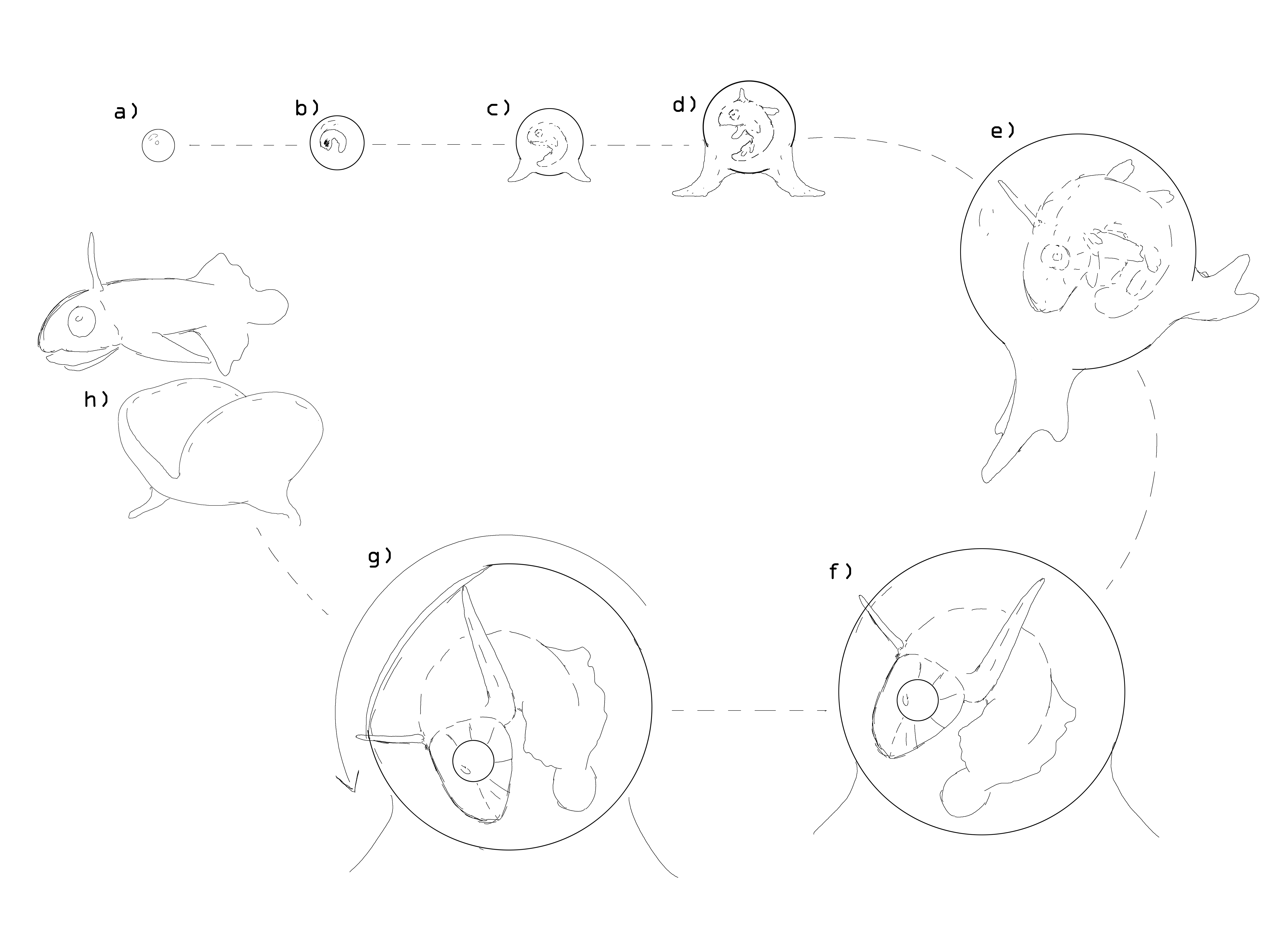The Egg Cycle and the function of the Natal Aculaeus
The Oviparous strategy
Several Ichthyomorphs from all over the subclade's Cladographic tree share egg-laying as a trait, usually after a short period of incubation inside the Oviduct. The eggs, when laid, are often just round, oddly coloured spheres (Image 1:1, figure a). Depending on the species, the eggs will take more or less time to develop, starting to sprout small peduncular-like anchors that will allow for the egg to latch to nearby objects and eggs (Image 1:1, figure c). These feet change in complexity and thickness depending on the species' preferred deposition habitat, having stronger peduncles in areas of high hydrodynamism and less developed ones in the opposite environment. As the fetus develops, the organism develops a calcified structure on the back of the parietal section of the developing cranium: The Natal aculeus (Image 1:1, figure d). This first draft of Dermocranial armour will eventually be vital for the animal during the last stages of development. The mostly formed fetus will gradually increase in size, up to the point where the Natal aculeus punctures through the outer egg wall (Image 1:1, figure f). When the animal is ready to hatch, it will rotate on itself, slicing the egg open and allowing the hatchling to be born. The natal aculeus will either be severed from the body as the base gets refurbished into the adult plating, absorbed to re-use the calcium or neotenized into the adult stage.The Ovoviviparous strategy
A significant amount of Ichthyomorphs adapted this secondary strategy which will result in live birth instead of egg-laying. Ovoviviparous Ichthyomorphs will incubate the eggs inside the oviduct for the entirety of the incubation period. Although the egg development inside the oviduct is very similar to the Oviparous ones, some key differences can be observed on the embryological and ethological level: Ovoviviparous animals will be born more developed than the hatchling coming from eggs laid outside of the mother's body; this is due to the higher concentration of nutrients the mother can give to the offspring while protected inside the parent; the internal temperature of the oviduct also plays a role in accelerating the growth of the fetus. Ovoviviparous animals will, with the exception of Cinerichthyds, give birth to a reduced amount of young compared to oviparous parents, favouring a K-styled Reproductive strategy, usually nursing the offspring more than the Oviparous animals. Some families of Ovoviviparous Ichthyomorphs will maintain the natal canal open for offspring to find refuge in for several weeks after birth, the main example being in Cinerichthyds. Several Ovoviviparous Ichthyomorphs will offer the young nutrition for the first phase of their life through liquids or greasy aids, which will help them survive the world outside the mother's natal canal or otherwise favour growth of a stronger immune system or the production of specific digestive enzymes. Ovoviviparous offspring are born with underdeveloped Natal aculei which often get absorbed or repurposed and rarely severed This last point is majorly induced by the offspring's birth being regulated by contractions of the oviduct compared to the fetus itself needing to free itself from the egg.The Natal Aculeus
The Natal Aculeus is the first Dermocranial element to develop in the fetus right after the formation of the Splanchnic- and Chondrocranial bones. Phylogenetically it originates from the base of the first to third dorsal plates of the postcranial armour, usually jetting out at an angle from the body, pointing caudally compared to the thorax. The Natal Aculeus is sharpened on the external side, acting as a scalpel to cut through the egg wall when development is finished and the young are ready to hatch. This structure is often kept for the first few days to months after hatching, acting as momentary protection from predators and aid for herbivorous animals in feeding as it can be used by many hatchlings that lack potent enough muscles to cut through the vegetation they feed upon. When neotenized, it will act as a defensive mechanism, retaining the sharp outer edge throughout the animal's life.Remove these ads. Join the Worldbuilders Guild










This is fascinating. I really like how you reference the image throughout the article so people can really get a feel for what you're talking about.